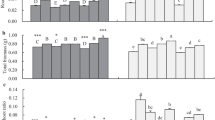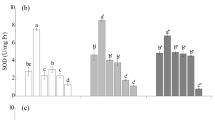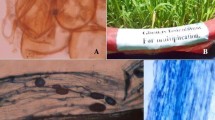Abstract
The ascomycetous dark septate endophytic (DSE) fungi characterized by their melanized hyphae can confer abiotic stress tolerance in their associated plants in addition to improving plant growth and health. In this study inoculation of the DSE fungus Nectria haematococca Berk. & Broome significantly improved all the plant growth parameters like the plant height, stem girth, leaf characteristics and plant biomass of drought-stressed tomato. Root characters like the total root length, primary root diameter, 2nd order root number and diameter, root hair number and length were also significantly influenced by the fungal inoculation. Nevertheless, N. haematococca inoculation did not affect root colonization by native arbuscular mycorrhizal (AM) fungi and no significant correlation existed between the AM and DSE fungal variables examined. The proline accumulation in shoots of N. haematococca inoculated plants was significantly higher than uninoculated plants. The present study clearly indicates for the first time the ability of the DSE fungus, N. haematococca in inducing the drought stress tolerance and promoting the growth of the host plant under water stress.


Similar content being viewed by others
References
Newsham KK (2011) A meta-analysis of plant responses to dark septate root endophytes. New Phytol 190:783–793. https://doi.org/10.1111/j.1469-8137.2010.03611.x
Muthukumar T, Sathiyadash K, Valarmathi V (2018) Arbuscular mycorrhizal and dark septate endophyte fungal associations in plants of different vegetation types in Velliangiri hills of Western Ghats, Southern India. Acta Bot Hung 60:185–222. https://doi.org/10.1556/034.60.2018.1-2.9
Smith SE, Read D (2008) Mycorrhizal symbiosis. Academic Press, London
Coleman JJ, Rounsley SD, Rodriguez-Carres M, Kuo A, Wasmann CC, GrimwoodJ Schmutz J, Taga M, White GJ, Zhou S, Schwartz DC, Freitag M, Ma LJ, VanEtten HD (2009) The genome of Nectria haematococca: contribution of supernumerary chromosomes to gene expansion. PLoS Genet 5(8):e1000618. https://doi.org/10.1371/journal.pgen.1000618
Summerell BA, Laurence MH, Liew ECY, Leslie JF (2010) Biogeography and phylogeography of Fusarium: a review. Fungal Divers 44:3–13. https://doi.org/10.1007/s13225-010-0060-2
Wu H, Yang HY, You XL, Li YH (2013) Diversity of endophytic fungi from roots of Panax ginseng and their saponin yield capacities. SpringerPlus 2:107. https://doi.org/10.1186/2193-1801-2-107
Banhos EF, Souza AQL, Andrade JC, Souza ADL, Koolen HHF, Albuquerque PM (2014) Endophytic fungi from Myrcia guianensis at the Brazilian Amazon: distribution and bioactivity. Braz J Microbiol 245:153–161. https://doi.org/10.1590/S1517-83822014005000027
Muthukumar T, Sathya R (2017) Endorhizal fungal association and colonization patterns in Solanaceae. Polish Bot J 62:287–299. https://doi.org/10.1515/pbj-2017-0016
Jackson ML (1973) Soil chemical analysis. Prince Hall of India (P) Limited, New Delhi
Feldmann F, Idezak E (1992) Inoculum production of vesicular-arbuscular mycorrhizal fungi for use in tropical nurseries. In: Norris JR, Read DJ, Varma AK (eds) Techniques for Mycorrhiza. I. Research methods in microbiology. Academic Press, London, pp 799–817
Pandey SK, Singh H (2011) A simple, cost-effective method for leaf area estimation. J Bot 2011: Article ID 658240, 2011. doi: https://doi.org/10.1155/2011/658240, p6
Sadasivam S, Manickam A (1996) Biochemical methods, 2nd edn. New Age International (P) Limited Publishers, New Delhi, pp 42–43
Newman EI (1966) A method for estimating the total length of root in a sample. J Appl Ecol 3:139–145. https://doi.org/10.2307/2401670
McGonigle TP, Miller MH, Evans DG, Fairchild GL, Swan JA (1990) A new method which gives an objective measure of colonization of roots by vesicular-arbuscular mycorrhizal fungi. New Phytol 115:495–501. https://doi.org/10.1111/j.1469-8137.1990.tb00476.x
Vergara C, Araujo KEC, Urquiaga S, Schultz N, Balieiro FC, Medeiros PS, Santos LA, Xavier GR, Zilli Jerri E (2017) Dark septate endophytic fungi help tomato to acquire nutrients from ground plant material. Front Microbiol. https://doi.org/10.3389/fmicb.2017.02437
Vergara C, Araujo KEC, Alves LS, Souza SR, Santos LA, Santa-Catarina C, Silva KD, Pereira GMD, Xavier GR, Zilli JÉ (2018) Contribution of dark septate fungi to the nutrient uptake and growth of rice plants. Braz J Microbiol 49:67–78. https://doi.org/10.1016/j.bjm.2017.04.010
Zhang Q, Gong M, Yuan J, Hou Y, Zhang H, Wang Y, Hou X (2017) Dark septate endophyte improves drought tolerance in sorghum. Int J Agric Biol 19:53–60. https://doi.org/10.17957/IJAB/15.0241
Umamaheswari T, Srimeena N, VasanthiN, Cibichakravarthy B, Anthoniraj S, Karthikeyan S (2016) Silica as biologically transmutated source for bacterial growth similar to carbon. Matts Arc https://doi.org/10.19185/matters.201511000005
Di X, Takken FLW, Tintor N (2016) How phytohormones shape interactions between plants and the soil-borne fungus Fusarium oxysporum. Front Plant Sci. https://doi.org/10.3389/fpls.2016.00170
Zhu ZB, Fan JY, Guo QS, Liu ZY, Zhu GS (2015) The growth and medicinal quality of Epimedium wushanense are improved by an isolate of dark septate fungus. Pharm Biol 53:1344–1351. https://doi.org/10.3109/13880209.2014.982296
Andrade-Linares DR, Grosch R, Restrepo S, Krumbein A, Franken P (2011) Effects of dark septate endophytes on tomato plant performance. Mycorrhiza 21:413–422. https://doi.org/10.1007/s00572-010-0351-1
Alberton O, Kuyper TW, Summerbell RC (2010) Dark septate root endophytic fungi increase growth of Scots pine seedlings under elevated CO2 through enhanced nitrogen use efficiency. Plant Soil 328:459–470. https://doi.org/10.1007/s11104-009-0125-8
Xu W, Cui K, Xu A, Nie L, Huang J, Peng S (2015) Drought stress condition increases root to shoot ratio via alteration of carbohydrate partitioning and enzymatic activity in rice seedlings. Acta Physiol Plant 37:9. https://doi.org/10.1007/s11738-014-1760-0
Wu QS, Zou YN (2010) Beneficial roles of arbuscular mycorrhizas in citrus seedlings at temperature stress. Sci Hortic 125:289–293. https://doi.org/10.1016/j.scienta.2010.04.001
Walter M, Boyd-Wilson K, Boul L, Ford C, McFadden D, Chong B, Pinfold J (2005) Field-scale bioremediation of pentachlorophenol by Trametes versicolor. Int Biodeterior Biodegrad 56:51–57. https://doi.org/10.1016/j.ibiod.2005.05.003
Elsharkawy MM, Shimizu M, Takahashi H, Hyakumachi M (2012) The plant growth-promoting fungus Fusarium equiseti and the arbuscular mycorrhizal fungus Glomus mosseae induce systemic resistance against Cucumber mosaic virus in cucumber plants. Plant Soil 361:397–409. https://doi.org/10.1007/s11104-012-1255-y
Saravesi K, Ruotsalainen AL, Cahill JF (2014) Contrasting impacts of defoliation on root colonization by arbuscular mycorrhizal and dark septate endophytic fungi of Medicago sativa. Mycorrhiza 24:239–245. https://doi.org/10.1007/s00572-013-0536-5
Bayat F, Mirlohi A, Khodambashi M (2009) Effects of endophytic fungi on some drought tolerance mechanisms of tall fescue in a hydroponics culture. Russ J Plant Physiol 56:563–570. https://doi.org/10.1134/S1021443709040104
Claussen W (2005) Proline as a measure of stress in tomato plants. Plant Sci 168:241–248. https://doi.org/10.1016/j.plantsci.2004.07.039
Verbruggen N, Hermans C (2008) Proline accumulation in plants: a review. Amino Acids 35:753–759. https://doi.org/10.1007/s00726-008-0061-6
Author information
Authors and Affiliations
Contributions
TM conceived the research and designed the experiment, PPSV carried out the experiment, and TM and PPSV wrote the manuscript. All authors read and approved the final manuscript.
Corresponding author
Ethics declarations
Conflict of interest
The Authors declared that they have no conflict of interests.
Rights and permissions
About this article
Cite this article
Prema Sundara Valli, P., Muthukumar, T. Dark Septate Root Endophytic Fungus Nectria haematococca Improves Tomato Growth Under Water Limiting Conditions. Indian J Microbiol 58, 489–495 (2018). https://doi.org/10.1007/s12088-018-0749-6
Received:
Accepted:
Published:
Issue Date:
DOI: https://doi.org/10.1007/s12088-018-0749-6




